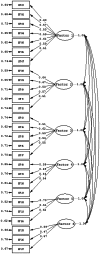Social functioning in Chinese college students with and without schizotypal personality traits: an exploratory study of the Chinese version of the First Episode Social Functioning Scale
- PMID: 23690922
- PMCID: PMC3653910
- DOI: 10.1371/journal.pone.0061115
Social functioning in Chinese college students with and without schizotypal personality traits: an exploratory study of the Chinese version of the First Episode Social Functioning Scale
Abstract
Objectives: The First Episode Social Functioning Scale (FESFS) was designed to measure social functioning of young individuals with schizophrenia. The aim of this study was to validate a Chinese version of the FESFS in a sample of young Chinese adults.
Method: The FESFS was translated to Chinese prior to being administered to 1576 college students. The factor structure, reliability, and validity of the scale were examined.
Results: Two items were deleted after item analysis and the internal consistency of the whole scale was .89. A six-factor structure was derived by exploratory factor analysis. The factors were interpersonal, family and friends, school, living skills, intimacy, and balance. Estimates of the structural equation model supported this structure, with Goodness of Fit Chi-Square χ(2) = 1097.53 (p<0.0001), the root mean square error of approximation (RMSEA) = 0.058, and the comparative fit index (CFI) = 0.93. Scale validity was supported by significant correlations between social functioning factors scores and schizophrenia personality questionnaire (SPQ) scores. Individuals with schizotypal personality features presented poorer social functioning than those without schizotypal personality features.
Conclusions: The Chinese revised version of the FESFS was found to have good psychometric properties and could be used in the future to examine social functioning in Chinese college students.
Conflict of interest statement
Figures

References
-
- Penn DL, Kohlmaier JR, Corrigan PW (2000) Interpersonal factors contributing to the stigma of schizophrenia: social skills, perceived attractiveness, and symptoms. Schizophr Res 45: 37–45. - PubMed
-
- Cochet A, Saoud M, Gabriele S, Broallier V, El Asmar C, et al. (2006) Impact of a new cognitive remediation strategy on interpersonal problem solving skills and social autonomy in schizophrenia. Encephale 32: 189–197. - PubMed
-
- Pinkham AE, Penn DL (2006) Neurocognitive and social cognitive predictors of interpersonal skill in schizophrenia. Psychiatry Res 143: 167–178. - PubMed
-
- Zanello A, Perrig L, Huguelet P (2006) Cognitive functions related to interpersonal problem-solving skills in schizophrenic patients compared with healthy subjects. Psychiatry Res 142: 67–78. - PubMed
-
- Green MF (1996) What are the functional consequences of neurocognitive deficits in schizophrenia? Am J Psychiatry 153: 321–330. - PubMed
Publication types
MeSH terms
LinkOut - more resources
Full Text Sources
Other Literature Sources
Medical
Miscellaneous

